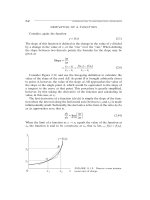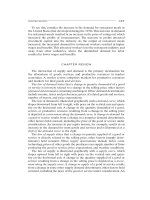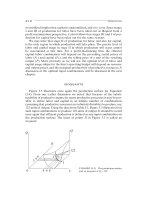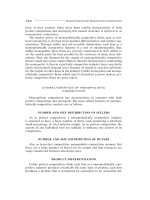El gamal islamic finance law, economics and practice (2006)
Bạn đang xem bản rút gọn của tài liệu. Xem và tải ngay bản đầy đủ của tài liệu tại đây (1.38 MB, 241 trang )
This page intentionally left blank
Islamic Finance
Law, Economics, and Practice
This book provides an overview of the practice of Islamic finance and the historical
roots that define its modes of operation. The focus of the book is analytical and forwardlooking. It shows that Islamic finance exists primarily today as a form of rent-seeking
legal arbitrage. An alternative that emphasizes substance rather than form would serve
religious and moral objectives better, through mutual and similar financial practices.
Mahmoud A. El-Gamal is Professor of Economics and Statistics at Rice University,
where he holds the endowed Chair in Islamic Economics, Finance, and Management.
Prior to joining Rice in 1998, he had been an associate professor of Economics at
the University of Wisconsin at Madison and an assistant professor of Economics at
California Institute of Technology and the University of Rochester. He has also served
in the Middle East Department of the International Monetary Fund (1995–6) and
as the first Scholar in Residence on Islamic Finance at the U.S. Department of the
Treasury in 2004. He has published extensively in the areas of econometrics, finance,
experimental economics, and Islamic law and finance.
Islamic Finance
Law, Economics, and Practice
Mahmoud A. El-Gamal
Rice University
cambridge university press
Cambridge, New York, Melbourne, Madrid, Cape Town, Singapore, São Paulo
Cambridge University Press
The Edinburgh Building, Cambridge cb2 2ru, UK
Published in the United States of America by Cambridge University Press, New York
www.cambridge.org
Information on this title: www.cambridge.org/9780521864145
© Mahmoud A. El-Gamal 2006
This publication is in copyright. Subject to statutory exception and to the provision of
relevant collective licensing agreements, no reproduction of any part may take place
without the written permission of Cambridge University Press.
First published in print format 2006
isbn-13
isbn-10
978-0-511-22021-0 eBook (EBL)
0-511-22021-9 eBook (EBL)
isbn-13
isbn-10
978-0-521-86414-5 hardback
0-521-86414-3 hardback
Cambridge University Press has no responsibility for the persistence or accuracy of urls
for external or third-party internet websites referred to in this publication, and does not
guarantee that any content on such websites is, or will remain, accurate or appropriate.
To
Father
& Mother,
who taught me
that religious forms
should continually serve
their central moral substance
Contents
List of Illustrations
page x
Preface
xi
Glossary and Transliteration
xv
1
Introduction
Finance without Interest?
1.1
Distinguishing Features of Islamic Finance
Prohibition-Driven Finance
Jurists, Shari‘a Boards, and Innovation
Lawyers and Regulatory Arbitrage
1.2
Islamic Transactions Law as Common Law
Precedents, Analogies, and Nominate Contracts
Tradeoff between Efficiency and Legitimacy
1.3
Limits and Dangers of Shari‘a Arbitrage
Risk of Mispricing
Legal and Regulatory Risks
1
2
7
8
11
13
15
17
20
21
22
23
2
Jurisprudence and Arbitrage
2.1
Islamic Law and Jurisprudence
The Canon: Qur’an, Tradition, and Consensus
Juristic Inference (Ijtihad) and Benefit Analysis
2.2
From Classical to Contemporary Jurisprudence
Jurisprudence, Revival, and Codification
Institution of Fatwa and Islamic Finance
2.3
Arbitraging Classical Jurisprudence
Shari‘a-Arbitraging Classical Property Law
Arbitraging Classical Contract Conditions
Arbitrage, Ruses, and Islamic Finance
26
27
27
28
30
31
32
35
36
42
44
vii
viii
Contents
3
Two Major Prohibitions: Riba and Gharar
3.1
The Prohibition of Riba
Canonical Texts on Riba
Economic Substance of the Prohibition of Riba
3.2
The Prohibition of Gharar
Definition of Gharar
Economic Substance of Prohibition
Insurance and Derivatives
3.3
Bundled vs. Unbundled Credit and Risk
46
49
49
52
58
59
60
61
62
4
Sale-Based Islamic Finance
4.1
Basic Rules for Sales
Trust Sales: Murabaha, Tawliya, Wad.i‘a
Currency Exchange (Sarf )
4.2
Same-Item Sale-Repurchase (‘Ina)
Same-Item Trading in ‘Ina and Tawarruq
Custody Sale (Bay‘ Al-‘uhda) and Sukuk Al-ijara
4.3
Cost of Funds: Interest-Rate Benchmarks
Opportunity Cost for Conventional Fund Providers
Viability of Islamic Benchmark Alternatives
64
65
67
68
70
70
73
74
75
77
5
Derivative-Like Sales: Salam, Istisna‘, and ‘Urbun
5.1
Prepaid Forward Sale (Salam)
Parallel Salam
Conventional and Synthesized Forwards
5.2
Commission to Manufacture (Istisna‘ )
5.3
Down-Payment Sale (‘Urbun)
‘Urbun as Call Option
81
81
83
86
90
91
92
6
Leasing, Securitization, and Sukuk
6.1
General Lease Conditions
Flexible-Rate Financing
Subleasing, Repairs, and Insurance Costs
6.2
Asset-Backed Securities
Leasing and Securitization
Receivable Securitization and Sale of Debt
Bundling Asset-Based and Debt-Based Securities: A Paradox
6.3
Asset-Backed Leasing Bonds (Sukuk)
Credit-Rating Issues
Reward Pledges and Gifts Revisited
6.4
Usufruct Sukuk
6.5
Sukuk Al-Salam
97
97
100
100
102
102
104
106
107
108
110
113
114
Contents
ix
7
Partnerships and Equity Investment
7.1
Classical Types of Partnership
Silent Partnership: Theoretical Workhorse of Islamic Finance
Valid and Defective Silent Partnerships
7.2
Common-Stock Ownership
“Islamic Screens” and Their Shortcomings
Cleansing Returns
Positive Screens and the Islamic Brand Name
117
117
120
122
123
125
133
134
8
Islamic Financial Institutions
8.1
Banking and Islamic Banking
Theoretical Structure: Two-Tier Silent Partnership
Deposits vs. Loans: Trust and Guaranty
8.2
Insurance and Takaful
8.3
Two Sides of the Two Debates
Shari‘a Arbitrage vs. Islamic Prudential Regulation
8.4
Generic Agency Characterization of Financial Institutions
135
137
138
144
147
151
152
153
9
Governance and Regulatory Solutions in Mutuality
9.1
Rent-Seeking Shari‘a Arbitrage and Absence of Mutuality
Potential for Mutuality in Islamic Banking
Need for Mutuality in Takaful
9.2
A Call for Mutuality in Banking and Insurance
Mutuality in Banking
Mutuality in Insurance
162
163
166
170
171
172
173
10
Beyond Shari‘a Arbitrage
10.1 Shari‘a Arbitrage and Criminal Finance
10.2 Shari‘a Arbitrage at the Limit
Benchmarking ad Absurdum
Hedge-Fund Instruments – Shari‘a-Arbitrage Style
10.3 Self-Destructiveness of Shari‘a Arbitrage
Declining Shari‘a-Arbitrage Profit Margins
Dilution of the “Islamic” Brand Name
10.4 Toward a New Islamic Finance Identity
Macroeconomic Substance: Privatization Sukuk
Mosque-Based Network of Financial Mutuals
Positive Screens, Ethical Investment
175
176
177
178
180
181
182
183
184
185
186
188
Conclusion
Notes
Bibliography
Index
190
193
213
219
List of Illustrations
1.1
1.2
1.3
1.4
1.5
5.1
5.2
5.3
6.1
6.2
Home Mortgage Transaction
Juristic Characterization of Mortgage Loan
Murabaha Alternative for Home Finance
Tabreed Sukuk Structure
Prisoners’ Dilemma
Forward Synthesized from Salam and Credit Sales
Al-Ahli Secured Fund Returns
Al-Rajhi Aman 1 Fund Returns
Structure of Qatar Global Sukuk
Structure of BMA Sukuk Al-Salam
x
3
4
5
7
10
87
94
95
108
115
Preface
In recent years, financial activities conducted under the banner of “Islamic finance” have grown significantly in volume and scope, attracting significant attention worldwide. Numerous books and articles have been published on the topic
over the past few decades. Their genres have ranged from highly religious treatises on Islamic law and worldview to highly practical surveys of the latest Islamic
financial products to reach the market. Why, one must ask, should one read – let
alone write – another book on the subject?
This book provides a qualitative overview of the practice of Islamic finance and
the historical roots that have defined its modes of operation. The purpose of the
book is not to survey the latest developments in this fast-growing industry. In
the current information age, such information is best obtained on the Internet,
since it requires updating at rates far exceeding the publication cycles of books
and journal articles.
The focus of this book is analytical and forward-looking. I show that, despite
the good intentions of its pioneers, Islamic finance has placed excessive emphasis
on contract forms, thus becoming a primary target for rent-seeking legal arbitrageurs. In every aspect of finance – from personal loans to investment banking, and from market structure to corporate governance of financial institutions
– Islamic finance aims to replicate in Islamic forms the substantive functions of
contemporary financial instruments, markets, and institutions.
This supposed Islamization of contemporary financial practice is accomplished
by means of modified premodern financial contracts (such as sales, leases, and
simple partnerships). The contracts are designed by teams of (1) financial professionals who make and cater to the market for “Islamic” products, (2) lawyers
who are skilled in the art of regulatory arbitrage, and (3) jurists or religious scholars who are familiar with medieval juristic texts (mostly in Arabic) and provide
certification of the Islamicity of various financial products and services.
xi
xii
Preface
˘
To make the classical juristic literature (on which the industry is built) accessible to English-reading audiences, I have provided a translation of one of the
most comprehensive surveys of classical Islamic jurisprudence and its contemporary understanding; see Al-Zuhayli (2003). The book in your hands contains the
argument that the classical jurisprudence in that survey aimed mainly to enhance
fairness and economic efficiency, subject to the legal and regulatory constraints of
premodern societies. In this regard, many of the intended economic and prudential regulatory functions of classical contract conditions are currently served by
other means that were made possible through advances in communication, legal
structures, and information technology.
By attempting to replicate the substance of contemporary financial practice using premodern contract forms, Islamic finance has arguably failed to serve the
objectives of Islamic Law (maqasid al-Shari a): Wherever the substance of contemporary financial practice is in accordance with Islamic Law, adherence to premodern contract forms (with or without modification) leads most often to avoidable efficiency losses, thus violating one of the main legal objectives that defined
classical Islamic jurisprudence. Conversely, by focusing on Islamicity of contract
forms rather than substance (in part to justify efficiency losses), Islamic finance has
often failed to serve the economic purpose for which certain premodern contract
structures were codified in classical jurisprudence. This book provides multiple
examples of both types of departure from serving Islamic legal objectives. The
case is also made that form-oriented Islamic finance is not sustainable in the long
term, because of (1) inherent dangers of using sophisticated structured finance
methods in Islamic countries with relatively unsophisticated regulators and (2)
competitive pressures that dictate convergence to efficient conventional financial
modes.
I propose refocusing Islamic finance on substance rather than form. This would
entail abandoning the paradigm of “Islamization” of every financial practice. It
would also entail reorienting the brand name of Islamic finance to emphasize
issues of community banking, microfinance, socially responsible investment, and
the like. In other words, I argue that the “Islamic” in “Islamic finance” should
relate to the social and economic ends of financial transactions, rather than the
contract mechanics through which financial ends are achieved. I provide specific
examples of areas where such reorientation of the brand name may in fact provide
value to individual customers of the industry, as well as society more generally.
A Note on Terms of Reverence
It is customary in Islamic writings to use terms of reverence when significant religious figures are mentioned. For instance, mention of the Prophet is traditionally
Preface
xiii
˘
˘
followed by the phrase “s.alla Allahu alayhi wa sallam” (may God bless him and
give him peace), and the mention of his companions is traditionally followed by
the phrase “rad.iya Allahu anhu” (may God be pleased with him). However, Western academic writings conventionally eliminate the use of such terms of reverence.
Following the latter convention, I shall not use terms of reverence in this book, as
non-specialists and non-Muslims may find them distracting. In the meantime, I
assure pious readers that I share their respect for all religious figures. I hope that
they will not be offended by omission of printed terms of reverence, which readers
may nonetheless vocalize at their discretion.
Mahmoud A. El-Gamal
Houston, December 2005
Glossary and Transliteration
˘
All¯ah – God.
am¯ana – trust, possession of.
aqd – contract.
b¯a.til – invalid (contract).
bay – sale.
bay al-am¯ana – variation on same-item sale-repurchase ( ¯ına).
bay al- ¯ına – same-item sale-repurchase.
bay al-k¯ali bi-l-k¯ali – trading one deferred obligation for another, forbidden
based on a tradition with questionable authenticity.
bay al- uhda – variation on same-item sale-repurchase ( ¯ına).
bay al-waf¯a – variation on same-item sale-repurchase ( ¯ına).
bay bi-thaman a¯ jil – credit sale.
companion – immediate follower of the Prophet.
d.am¯an – guaranty, possession of.
d.arar – harm or injury.
dayn – debt or liability for fungible property.
d¯ın¯ar – Roman gold coins, adopted as currency in early Islam.
dirham – Persian silver coins, adopted as currency in early Islam.
f¯a ida – (literally: benefit) interest, plural faw¯a id.
f¯asid – defective (contract).
fatw¯a – religious edict or opinion, plural fat¯aw¯a, anglicized plural fatwas.
fiqh – juristic understanding or inference based on Shar¯ı a.
fud.u¯ l¯ı – uncommissioned agent.
gharar – risk or uncertainty, forbidden if excessive and avoidable.
h.ad¯ıth – report of Prophetic or other early Islamic tradition.
H
. an¯ıfa, see note 24, Chapter 2.
. anaf¯ı – belonging to the juristic school of Ab¯u H
H
anbal¯
ı
–
belonging
to
the
juristic
school
of
Ah
mad ibn H
.
. anbal, see note 24,
.
Chapter 2.
˘
˘
˘
˘
˘ ˘
˘
˘
˘
˘ ˘ ˘
˘
˘ ˘ ˘ ˘
˘
xv
Glossary and Transliteration
xvi
˘
hiba – gift.
hijra – the Prophet’s migration from Makka to Yathrib (later called Madina).
h.¯ıla – ruse, legal stratagem to circumvent various prohibitions, plural h.iyal.
h.ukm Shar ¯ı – Islamic legal status ruling.
¯ıd¯a – fiduciary deposit contract.
ij¯ara – lease or hire contract.
ijm¯a – juristic consensus.
ijtih¯ad – juristic inference.
illa – juristic reason or grounds for analogy.
iq¯ala – contract revocation.
istih.s¯an – juristic approbation, to overrule juristic analogy.
istis.l¯ah. – benefit analysis, to overrule juristic analogy.
istis.n¯a – commission to manufacture.
Jam¯a at-i-Isl¯am¯ı – Islamist party founded by Pakistani writer Abu Al-A l¯a AlMawd¯ud¯ı.
ji a¯ la – pledge to make payment.
jurist – faq¯ıh, a specialist in Islamic jurisprudence.
kaf¯ala – guaranty offered on behalf of some party.
M¯alik¯ı – belonging to the juristic school of M¯alik ibn Anas, see note 24, Chapter
2.
manfa a – usufruct of a property.
maq¯a.s.sa – mutual debt clearance.
mas.lah.a – public or private benefit, plural mas.a¯ lih..
mud.a¯ raba – silent partnership.
muft¯ı – jurist who issues fatw¯a.
mur¯abah.a – cost-plus sale, often combined with bay bi-thaman a¯ jil.
Al-Ikhw¯an Al-Muslim¯un – Muslim Brotherhood, Islamist group founded by Egyptian teacher H
. assan Al-Banna.
qard. – loan of fungible property.
qir¯ad. – silent partnership.
qiy¯as – juristic inference by analogy.
Qur a¯ n – ultimate Islamic canon, believed to be the revealed word of God.
rahn – collateral or pawned property in lieu of debt.
rib¯a – major prohibition of Islam, similar but not equivalent to either usury or
interest, see Chapter 3.
ribaw¯ı – property subject to the rules of rib¯a.
.sakk – bond or certificate, plural .suk¯uk.
salam – forward sale with prepaid price.
sanad – bond or certificate, plural sanad¯at.
s.arf – currency exchange contract.
˘
˘
˘
˘
˘
˘
˘
˘
˘
˘
Glossary and Transliteration
xvii
˘
˘
˘
˘
Sh¯afi ¯ı – belonging to the juristic school of Muh.ammad ibn Idr¯ıs Al-Sh¯afi ¯ı, see
note 24, Chapter 2.
Shar¯ı a – revealed divine law in Qur a¯n and Sunna.
sharika – partnership, see Chapter 7 for various types.
.suk¯uk – bonds or certificates, plural of .sakk.
Sunna – Prophetic or other early Islamic tradition.
tabarru – voluntary contribution.
tak¯aful – mutual guaranty or insurance, used differently in Islamic finance, see
Chapter 8.
takhr¯ıj fiqh¯ı – juristic recharacterization of a contract or transaction (usually forbidden) in terms of another (usually permissible).
tawarruq – three-party variation on bay al- ¯ına.
tawliya – sale at cost.
urb¯un – down payment on purchase, from which call options are routinely synthesized.
urf – customary practice, appeals to which may overrule juristic analogy.
wad¯ı a – fiduciary deposit.
wad.¯ı a – sale below cost.
wak¯ala – agency.
waqf – trust or mortmain, plural awq¯af.
zak¯ah – obligatory Islamic wealth tax.
˘
˘
˘
˘
˘
˘ ˘
1
Introduction
In his Address to the Nobility of the German Nation in 1520, Martin Luther wrote:
A cobbler, a smith, a peasant, every man, has the office and function of his calling, and yet
all alike are consecrated priests and bishops, and every man should by his office or function
be useful and beneficial to the rest, so that various kinds of work may all be united for the
furtherance of body and soul, just as the members of the body all serve one another.1
˘
A cobbler was said to have asked Luther how he could serve God within his trade
of shoe making. Luther’s answer was not that the cobbler should sell a “Christian
shoe,” but rather that he should make a good shoe and sell it at a fair price.2 Most
interesting in Luther’s quote is the similarity of his message to Sunni Islamic traditions, wherein – at least in theory – there are no distinct categories of clergy and
laity, and wherein all righteous acts – including fair dealings in the marketplace –
are considered important parts of religious life.3
The term “Islamic finance” brings to mind an analogy to the concept of a
“Christian shoe,” rather than to good products that are fairly priced. Indeed, we
shall see that the primary emphasis in Islamic finance is not on efficiency and
fair pricing. Rather, the emphasis is on contract mechanics and certification of
Islamicity by “Shari a Supervisory Boards.” To the extent that “Islamic” financial
products also cost more than the conventional products that they seek to replace
– partly because of relative inefficiency, and partly to cover otherwise unnecessary
jurist and lawyer fees – one may make partial analogies between those certifications and the European pre-Reformation practice of selling indulgence certificates.
Thus, quoting Luther at the outset seems doubly appropriate, since he was simultaneously driven to oppose religious peddling through the sale of indulgences as
well as usurious practices camouflaged by the mechanics of legitimate business
and finance.4
In fact, the expression “Islamic finance” suggests two competing forces at work.
The noun “finance” suggests that Islamic financial markets and institutions deal
1
Introduction
2
with the allocation of financial credit and risk. Thus, Islamic finance must be
essentially similar to other forms of finance. On the other hand, the adjective
“Islamic” suggests some fundamental differences between Islamic finance and its
conventional counterpart. Observers of the theory and practice of Islamic finance
sense this tension between attempts to be essentially similar to conventional finance (emphasizing competitiveness and efficiency) and attempts to preserve a
distinctive Islamic character (emphasizing Arabic contract names and certification
by religious scholars). We shall see in future chapters that this “Islamic” distinction often can be preserved only at a cost, and minimization of that cost – driven
by competitive pressures – may render it a distinction of form without substance.
Finance without Interest?
˘
Most readers encounter Islamic finance first through grossly simplistic statements
such as “Islam (or the Qur an) forbids interest.” This has given rise to countless
jokes about “how one can get an Islamic interest-free mortgage loan.” Even relatively sophisticated journalists follow this process of false reductionism, followed
by tongue-in-cheek qualifications. For instance, in a recent article in Fortune magazine, Useem (2002) reported on typical Islamic financing through credit sales,
known by the Arabic name murabaha, the details of which we shall examine in
some detail in Chapter 4. Reflecting on the transaction, he exclaimed:
The result looked a lot like interest, and some argue that murabaha is simply a thinly veiled
version of it; the markup [bank’s name] charges is very close to the prevailing interest rate.
But bank officials argue that God is in the details.
This tongue-in-cheek quotation of the statement that “God is in the details”
may otherwise be viewed as offensive and condescending. However, it is surprisingly tolerated, and sometimes nurtured, within Islamic finance circles. It reflects
the prevailing form-above-substance approach of that industry. Islamic financial
forms are derived, albeit loosely, from classical sources of Islamic jurisprudence,
which process of derivation gives the industry its “Islamic” label.
In fact, there are numerous instances wherein reporters begin by stating that
the distinguishing feature of Islamic finance is the prohibition of interest and
then proceed to report the interest rate that Islamic instruments pay. For instance, Reuters’ August 13, 2002, coverage of Bahrain’s $800 million sukuk (the
Arabic term for “Islamic bonds”) followed their characterization of Islamic financial products as “interest-free” with a report that those sukuk will pay “4 percent
annual profit.” Customary explanations that the transaction is asset-based, or that
what appears similar to interest is in fact profit in a sale or rent in a lease, can
often leave the uninitiated reader more perplexed about the “interest-free” charac-
Introduction
3
terization. To provide concrete understanding of the mechanics and justifications
of Islamic finance, we now proceed to consider two examples of popular Islamic
structures at the retail and investment banking levels.
Example 1 : Home Mortgage Transaction
For the first example, we begin with a conventional mortgage transaction as conducted in many states in the United States. The main components of my mortgage loan transaction in the state of Texas are illustrated in Figure 1.1.
Financial Institution (mortgagee)
$$ Balance
(mortgage
loan amount)
$$
Mortgage
payments
according to
amortization
schedule
Lien on
property
+ Loan
documents
Title
Company
$$ Down
payment
+
Loan
documents
Home Buyer (mortgagor)
Title
$$ Home
price
Title
Home Seller (clean title)
Fig. 1.1. Home Mortgage Transaction
The “closing” of this transaction took place at the title company offices. I
brought a certified check for the amount of my down payment on the house (20
percent of the price plus closing costs), payable to the title company. The latter
simultaneously collected the balance (80 percent) from my prospective mortgagee
and subsequently issued a check to the seller for the sale price. I signed mortgage
loan documents for the amount my mortgagee paid, promising to make mortgage
payments according to the agreed-upon amortization schedule. I also had the
option to prepay my balance, thus saving on financing charges, and obtaining
clean title to the property at an earlier date, if I wished. In the meantime I received
a title to the property, while my mortgagee obtained a lien thereon, thus restricting
my ability to sell it without its permission.
Introduction
4
The mechanics of this mortgage transaction are similar to numerous other
forms of secured lending that evolved in modern times, made possible through
searchable title databases that protect borrowers’ and lenders’ interests. Most
Islamic jurists consider this transaction a form of forbidden riba (discussed in
greater detail in Chapter 3), characterizing the various components of my mortgage as shown in Figure 1.2. According to this characterization, I borrowed a cer-
Financial Institution (mortgagee)
$$
Mortgage
payments
according to
amortization
schedule
Lien
on property
+ Loan
documents
$$ Mortgage
loan amount
$$ Home
price
Home Buyer (mortgagor)
Home Seller (clean title)
Title
Fig. 1.2. Juristic Characterization of Mortgage Loan
tain amount of money from my mortgagee and promised to pay a larger amount
of money in the future. This constitutes an interest-bearing loan of money, which
the overwhelming majority of jurists (though not all) consider to be a form of the
forbidden riba.5 Thus, by separating the loan from the sale contract for which
it was intended, jurists equally condemn secured loans (such as mortgages) and
unsecured loans (such as credit card balances).
One “Islamic” alternative that has been very popular in Islamic finance is the
use of multiple sales in a murabaha transaction, as shown in Figure 1.3. In this
transaction the eventual mortgagee must first purchase the property from the
seller, obtaining title either directly or through a special-purpose vehicle (SPV).
Then, the bank may turn around and sell the property on credit to the mortgagor,
using amortization tables that are often calculated based on the same interest rate
Introduction
5
Financial Institution (mortgagee)
$$
Mortgage
payments
according to
amortization
schedule
$$ Down
payment +
“Islamic
mortgage”
documents
+ Lien
on property
Home Buyer (mortgagor)
Title
$$ Home
price
Title
Home Seller (clean title)
Fig. 1.3. Murabaha Alternative for Home Finance
used for conventional mortgages. One juristic difference, according to Islamic
finance practitioners, is that the mortgagor in this case is involved in a credit sale
contract, rather than a loan contract. In fact, because of requirements of some
jurisdictions in the United States, and government-sponsored enterprises that assist with mortgage securitization, signed documents often contain terms such as
“note,” “loan,” “borrower,” and “interest.” However, jurists have argued, the contract remains one of permissible trade rather than forbidden borrowing with interest. Depending on jurisdiction, the requirement of multiple sales, special-purpose
vehicles, and documentations of title may add tax as well as legal costs. A second major difference to which jurists point is the peculiar structure that Islamic
banks use for late payment penalties. We shall return to the basic secured lending
transaction and its “Islamic alternative” in Chapter 4.
Example 2: Islamic Bond (Sukuk) Structure
For our second example, we consider a highly celebrated US$100 million corporate Islamic bond (sukuk) issue by Tabreed Financing Corporation in March
2004. The corporate entity “Tabreed Financing Corporation” is a limited company SPV incorporated in the Cayman Islands for the purpose of issuing the









